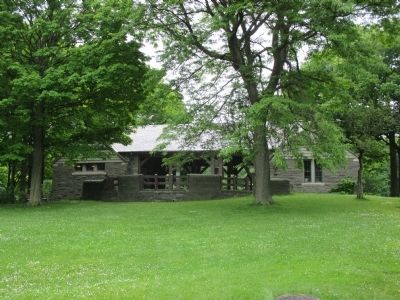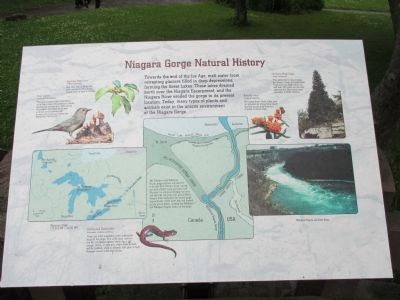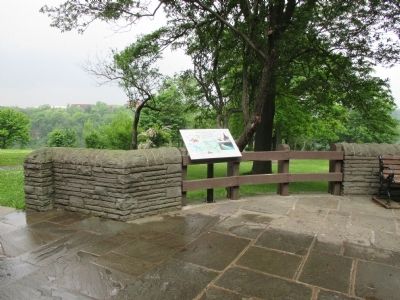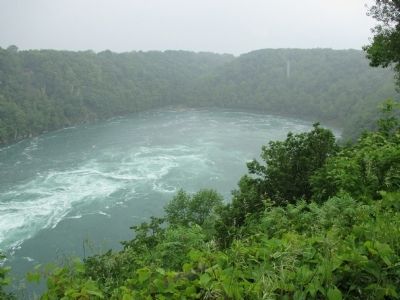Niagara Falls in Niagara County, New York — The American Northeast (Mid-Atlantic)
Niagara Gorge Natural History
Towards the end of the Ice Age, melt water from retreating glaciers filled in deep depressions, forming the Great Lakes. These lakes drained north over the Niagara Escarpment, and the Niagara River eroded the gorge to its present location. Today, many types of plants and animals exist in the unique environment of the Niagara Gorge.
The Whirlpool and Whirlpool Rapids gorge sections are believed to be part of the St. David's Gorge, carved out about 28,000 years ago before the Late Wisconsin ice advanced through the area and filled the old gorge with glacial debris. Niagara Falls intersected this buried gorge approximately 4,500 years ago and flushed out the glacial debris, opening the Whirlpool and Whirlpool Rapids section of the gorge. American Bittersweet. Celastrus scandens. This vine, with its flashy red seed surrounded by a bright orange husk, is easy to identify. Gray Catbird. Dumetella carolinensis. This gray songster can be identified by its black-capped head and by a small, hard-to-see chestnut spot under its tail. The catbird often flicks its tail and is known for its mewing call. Courtesy of the Cornell Lab of Ornithology. Photographer: Mike Hopiak.
Red-backed Salamander. Plethodon cinereus cinereus. There are a few variations of this salamander found in the gorge. Two of the most common are the red-backed variant, which has a red, orange, or light gray stripe down its back, and the leadback, which is uniformly dark gray to black. Photograph courtesy of Allen Blake Sheldon.
Northern White Cedar. Thuja occidentalis. This native tree is unique along the Niagara Gorge and escarpment. Some northern white cedars are well over 400 years old and may represent the oldest intact forest ecosystem in North America.
Butterfly-weed. Asclepias tuberosa. The orange flower heads of this plant are pollinated by strong, flying insects that have to pull at the hard sacs of pollen to release them.
Topics. This historical marker is listed in this topic list: Natural Features.
Location. 43° 7.208′ N, 79° 3.878′ W. Marker is in Niagara Falls, New York, in Niagara County. Marker can be reached from Niagara Scenic Parkway (New York State Route 957A). Marker is located in Whirlpool State Park, accessible from the Niagara Scenic Parkway. Marker is located at the rear deck of tourist shelter. Touch for map. Marker is in this post office area: Niagara Falls NY 14303, United States of America. Touch for directions.
Other nearby markers. At least 8 other markers are within walking distance of this marker. Challenging the Whirlpool Rapids (a few steps from this marker); Welcome to Whirlpool State Park (within shouting distance of this marker); Eddy Basin (within shouting distance of this marker);
Whirlpool Rapids (about 300 feet away, measured in a direct line); Niagara Spanish Aero Car (approx. ¼ mile away in Canada); Pastimes and Parkways (approx. half a kilometer away); Whirlpool Rapids Gorge (approx. half a kilometer away in Canada); Thompson Point (approx. 0.6 kilometers away in Canada). Touch for a list and map of all markers in Niagara Falls.
Also see . . . Whirlpool State Park. New York State Parks, Recreation and Historic Preservation website entry:
No entrance fee. (Submitted on June 22, 2014, by Anton Schwarzmueller of Wilson, New York.)

Photographed By Anton Schwarzmueller, June 13, 2014
3. Location of Niagara Gorge Natural History Marker
This is the rear of the tourist shelter. The marker is along the right of the semi-circle deck, facing the shelter. The "Challenging the Whirlpool Rapids" marker is similarly situated along the left of the deck. The shelter faces the parking lot.
Credits. This page was last revised on January 4, 2022. It was originally submitted on June 22, 2014, by Anton Schwarzmueller of Wilson, New York. This page has been viewed 435 times since then and 28 times this year. Photos: 1, 2, 3, 4. submitted on June 22, 2014, by Anton Schwarzmueller of Wilson, New York. • Bill Pfingsten was the editor who published this page.


